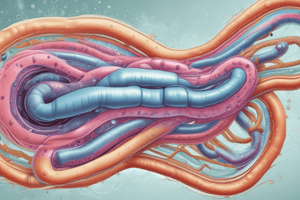Podcast
Questions and Answers
What is the primary reason why direct person-to-person spread of V. cholerae is rare?
What is the primary reason why direct person-to-person spread of V. cholerae is rare?
- The infectious dose is low.
- The infectious dose is high. (correct)
- The organisms are susceptible to acid.
- The organisms are not susceptible to acid.
Why are fewer organisms required to cause infection when the vehicle is food?
Why are fewer organisms required to cause infection when the vehicle is food?
- The acidic environment of the stomach increases the infectious dose.
- The buffering capacity of food decreases the infectious dose. (correct)
- The alkaline environment of the intestine decreases the infectious dose.
- The buffering capacity of food increases the infectious dose.
What is the optimal timing for culturing stool specimens for V. cholerae diagnosis?
What is the optimal timing for culturing stool specimens for V. cholerae diagnosis?
- Early in the course of the disease. (correct)
- During the incubation period.
- After symptoms have resolved.
- Late in the course of the disease.
What increases a person's susceptibility to V. cholerae infection?
What increases a person's susceptibility to V. cholerae infection?
What is the primary mode of transmission of V. cholerae?
What is the primary mode of transmission of V. cholerae?
What is the typical incubation period of V. cholerae infection?
What is the typical incubation period of V. cholerae infection?
What is the clinical presentation of V. cholerae infection?
What is the clinical presentation of V. cholerae infection?
What percentage of V. cholerae infections are asymptomatic?
What percentage of V. cholerae infections are asymptomatic?
Which species of bacteria can be identified based on their growth at 42°C?
Which species of bacteria can be identified based on their growth at 42°C?
What is the recommended counterstain for Carbol-fuchsin?
What is the recommended counterstain for Carbol-fuchsin?
What is the ideal temperature for incubating a specimen for H. pylori?
What is the ideal temperature for incubating a specimen for H. pylori?
What is the major cause of type B gastritis?
What is the major cause of type B gastritis?
What is the estimated percentage of the population worldwide infected with H. pylori?
What is the estimated percentage of the population worldwide infected with H. pylori?
What is the ideal atmosphere for incubating a specimen for Campylobacter?
What is the ideal atmosphere for incubating a specimen for Campylobacter?
What is the specimen of choice for C. fetus?
What is the specimen of choice for C. fetus?
What is the characteristic of Campylobacter species?
What is the characteristic of Campylobacter species?
What is the primary disease caused by Campylobacter jejuni?
What is the primary disease caused by Campylobacter jejuni?
What is the shape of Campylobacter jejuni rods?
What is the shape of Campylobacter jejuni rods?
How is Campylobacter jejuni often transmitted?
How is Campylobacter jejuni often transmitted?
What is the characteristic of Vibrio species in stools?
What is the characteristic of Vibrio species in stools?
What is the consequence of rapid loss of fluid and electrolytes in Campylobacter jejuni infection?
What is the consequence of rapid loss of fluid and electrolytes in Campylobacter jejuni infection?
Which serotype of Campylobacter jejuni is responsible for major pandemics?
Which serotype of Campylobacter jejuni is responsible for major pandemics?
Flashcards are hidden until you start studying
Study Notes
Cholera
- Direct person-to-person spread is rare due to high infectious dose
- Stomach acids kill most Vibrio cholerae organisms
- Normal gastric acidity requires ingestion of 1000+ V.cholerae to become infected through contaminated water
- Food buffering capacity reduces the infectious dose to 102-104 organisms
- Diagnosis involves microscopic examination and stool culture
- Medications or conditions reducing stomach acidity increase susceptibility to infection
- Fluid and electrolyte replacement are crucial for treatment
- Antibiotics such as doxycycline, trimethoprim-sulfamethoxazole, or furazolidone are administered
- About 60% of infections are asymptomatic
- Improved hygiene is critical for control
- Incubation period is 1-4 days
Campylobacter
- Sudden onset of nausea, vomiting, and profuse diarrhea with abdominal cramps
- Organisms exhibit darting motility on hanging drop preparations or phase contrast microscopy
- Most clinically relevant species are C.jejuni subsp.jejuni, C.coli, and C.fetus subsp
- Inoculation of specimen to campylobacter blood agar and incubation in microaerophilic atmosphere
- Oxidase-positive, catalase-positive campylobacter species can be differentiated based on growth at 42°C
- Stools resemble rice water and contain mucus, epithelial cells, and large numbers of Campylobacter
- Rapid loss of fluid and electrolytes leads to dehydration, circulatory collapse, and anuria
- Often transmitted by contaminated water and animals, especially poultry and carcasses
- Campylobacter fetus is the causative agent of bacteremia
Helicobacter
- Identified in 80% of gastric ulcer patients
- Estimated that 50% of the population worldwide is infected with H.Pylori
- Higher incidence attributed to poor sanitary conditions, with infection occurring early in life
- Major cause of type B gastritis, a chronic condition formerly associated with stress and chemical irritants
Studying That Suits You
Use AI to generate personalized quizzes and flashcards to suit your learning preferences.




